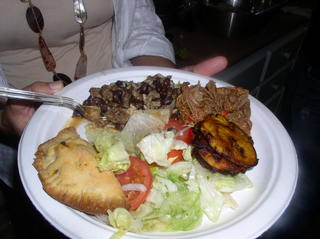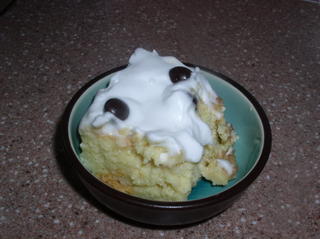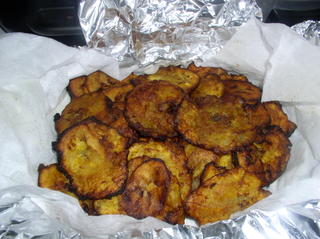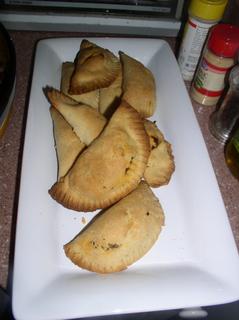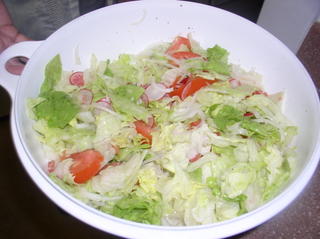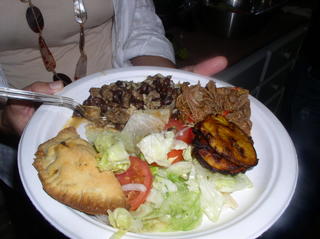 DON'T LET THIS RECIPE SCARE YOU. I know it seems like a lot of work and ingredients, but here are a few tips that helped me:
First, cut all the veggies first and set in the fridge. I only used red and yellow peppers. Secondly, I only used one thinly sliced onion. And third, I didn't used the can of whole tomatoes. Instead, I used a one (7 oz) can of El Pato tomato sauce. I ommited the olives and the big secret: I used a 1-1/2 pound brisket instead of flank steak that I cooked the day before and shredded and set in the fridge. On the day of the party, I just finished the rest of the recipe. You can find the original Ropa Vieja recipe I used on Oprah.com, however my tweaked recipe below came out just as good.
INGREDIENTS
DON'T LET THIS RECIPE SCARE YOU. I know it seems like a lot of work and ingredients, but here are a few tips that helped me:
First, cut all the veggies first and set in the fridge. I only used red and yellow peppers. Secondly, I only used one thinly sliced onion. And third, I didn't used the can of whole tomatoes. Instead, I used a one (7 oz) can of El Pato tomato sauce. I ommited the olives and the big secret: I used a 1-1/2 pound brisket instead of flank steak that I cooked the day before and shredded and set in the fridge. On the day of the party, I just finished the rest of the recipe. You can find the original Ropa Vieja recipe I used on Oprah.com, however my tweaked recipe below came out just as good.
INGREDIENTS
- 1-1/2 to 2 pound Brisket
- kosher salt
- 3/4 tsp. freshly ground black pepper
- 2 Tbsp. of flour
- 5 Tbsp. extra virgin olive oil
- 4 cups homemade chicken stock or low-sodium chicken broth
- 2 bay leaves
- 1 Tbsp. whole black peppercorns
- 1 large Spanish onions, thinly sliced
- 1 red bell pepper, cored, seeded and thinly sliced
- 1 yellow bell pepper, cored, seeded and thinly sliced
- 1-1/2 tsp. ground cumin
- 2 large garlic cloves, thinly sliced
- 1 Tbsp. tomato paste
- 1 (7-1/4 ounce) can of El Pato Tomato Sauce
Season brisket with 1/2 teaspoon salt and 1/2 teaspoon pepper. Lightly dust it with the flour.
In a heavy-bottomed 5- to 6-quart pot, heat 2 tablespoons oil over medium-high heat. Add the brisket to pot and cook until well browned, about 2 minutes per side.
 Add chicken broth, bay leaves, peppercorns, 1 tsp. of the cumin, and 1/2 teaspoon salt (you can also add any leftover veggies like onions, peppers or carrots). The brisket should be just covered with broth; pour in additional broth or water, if necessary. Bring to a boil; reduce heat to low and simmer, covered, until steak is fork-tender, 2-1/4 to 2-1/2 hours. Remove pot from heat and let brisket cool in broth for 30 minutes.
Add chicken broth, bay leaves, peppercorns, 1 tsp. of the cumin, and 1/2 teaspoon salt (you can also add any leftover veggies like onions, peppers or carrots). The brisket should be just covered with broth; pour in additional broth or water, if necessary. Bring to a boil; reduce heat to low and simmer, covered, until steak is fork-tender, 2-1/4 to 2-1/2 hours. Remove pot from heat and let brisket cool in broth for 30 minutes.
Transfer brisket to a plate. Strain cooking liquid through a sieve set over a bowl; Let liquid stand 5 minutes, then skim off and discard any fat. Set cooking liquid aside. Cut the brisket in half then shred the brisket by pulling off sting-like meat.
 Tip: You can do these steps the day before, set it in the fridge and continue with the rest of the recipe the next day.
Tip: You can do these steps the day before, set it in the fridge and continue with the rest of the recipe the next day.
In the same pot, heat 2 tablespoons oil over medium heat. Add thinly sliced onions, red and yellow peppers, garlic, 1/2 teaspoon cumin, 1/2 teaspoon salt, and 1/4 teaspoon pepper. Cook, stirring frequently, until onions and peppers soften, 15 to 20 minutes.
Stir in tomato paste until vegetables are coated. Stir in the shredded brisket meat and the tomato sauce, until all is coated. Add in 2 1/2 cups of the reserved cooking liquid, and 1/4 teaspoon salt. Bring to a boil; reduce heat to low and simmer until slightly thickened, about 20 minutes.
Taste and adjust seasoning with additional salt and pepper if necessary. If not serving immediately, cool, cover, and refrigerate for up to 2 days; flavor will only improve upon standing. Serve with Moros y Cristianos or platanos maduros.

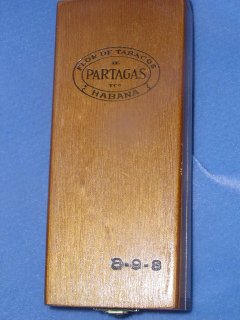 The tasty Cuban Cigars Mr. Matthew provided for us. These were Partagas cigars, straight from Havana.
Ana, Britta and Lindsey.
The tasty Cuban Cigars Mr. Matthew provided for us. These were Partagas cigars, straight from Havana.
Ana, Britta and Lindsey.

